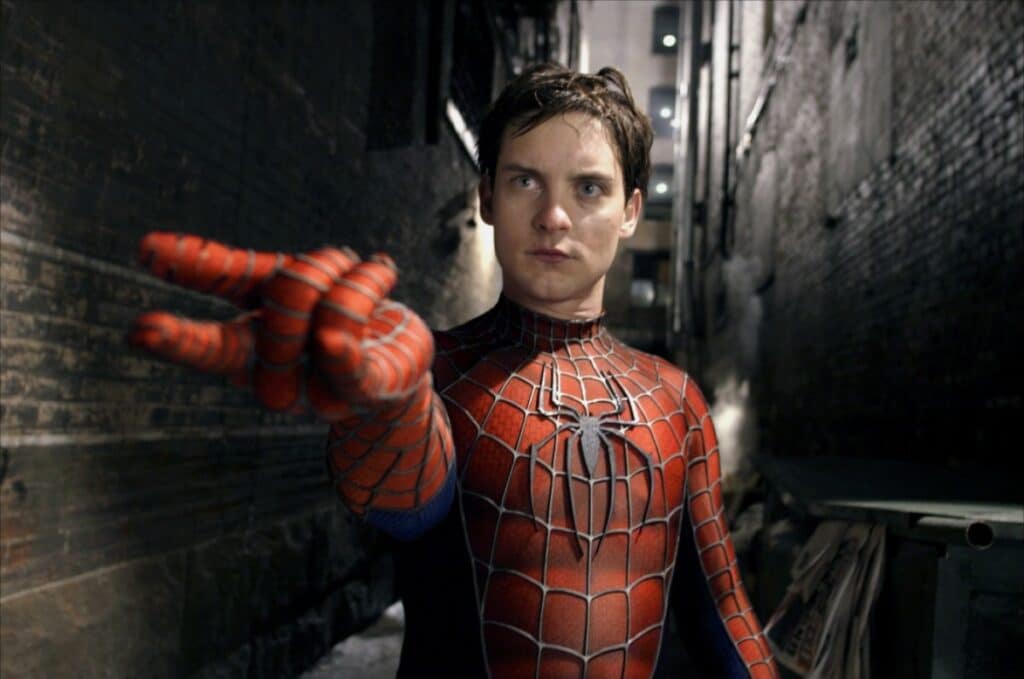Every month, we at The Spool select a filmmaker to explore in greater depth — their themes, their deeper concerns, how their works chart the history of cinema, and the filmmaker’s own biography. October sees not only the onset of Halloween but the birthday of cult horror maestro-turned-mainstream filmmaker Sam Raimi; all month, we’re web-slinging through his vibrant, diverse filmography. Read the rest of our coverage here.
In the midst of a world fully encompassed by superhero films as a genre unto itself, it almost feels revolutionary to step back into the world of the mid-2000s. The idea of cinematic universes was but a gleam in the eye of a young Kevin Feige, and superhero movies stemming from the world of Marvel comics were still an unknown entity for filmmakers to experiment with. That is, even if most of those experiments ended up as failures in the long run.
But if Bryan Singer’s X-Men in 2000 brought back the superhero film as something to be taken seriously, then Sam Raimi’s 2002 slam-dunk Spider-Man cemented the genre as a breeding ground for aesthetic reinterpretation. Raimi’s Spider-Man films effortlessly combine horror, drama, comedy, and trace elements of Camp into something that feels as much an extension of comic books as it does a visually compelling blockbuster. Probably only Ang Lee’s Hulk or Edgar Wright’s Scott Pilgrim vs. the World come close to emulating the visual scope and balancing act of tones that come with comic books.
Spider-Man 2, frequently cited as one of the definitive entries in the genre, only builds upon this aesthetic. The quick cuts, zooms, and images upon images support a vision that makes The Avengers look like Law and Order: SVU by comparison. Seeing J. Jonah Jameson (J. K. Simmons) yell into the sky, “I want Spider-Man!” followed by a newspaper spinning out of his mouth is one thing. Spider-Man subsequently bursting out of that newspaper makes for a moment with more cartoonish adrenaline than the Marvel Cinematic Universe combined.

But it’s the emotional truth of Spider-Man 2, and the tug-of-war between Peter Parker’s public and personal lives, that pushes the film into all-star territory. After an opening credits sequence accompanied by Danny Elfman’s masterful score, the film picks up two years after the events of the first movie. Mary-Jane Watson’s acting career is hitting new heights. Harry Osborn is still reeling from the death of his father at the hands of who he thinks is Spider-Man All the while, Peter is struggling to reconcile his personal life with his chosen path as New York’s friendly neighborhood Spider-Man. Sure, he’s stopping crime and saving lives on a daily basis, but the kid still can’t deliver a pizza in 29 minutes or less.
It’s only after Peter’s web-slinging antics cause him to be late for MJ’s performance of The Importance of Being Earnest that Peter starts to reckon with his self-appointed duty. If he can’t even maintain the relationships that drive him in the first place, is it really worth it? So Peter gives up the suit and tries to focus more on his academics, his Aunt May, and his burgeoning will-they-won’t-they relationship with MJ. Spider-Man 2 is buoyed by an altogether iconic cast, with Tobey Maguire, Kirsten Dunst, and James Franco all providing youthful angst and charm to their respective roles of Peter, MJ, and Harry.
It’s Alfred Molina as Otto Octavius (Doctor Octopus to his enemies), though, that ultimately steals the film, bringing equal parts menace and paternal energy to the power-hungry Doc Ock. His hubris causes his fusion energy experiment to literally explode in his face, fusing him with his terrifying electronic arms. (The sequence where his arms attack an entire room of doctors has to be one of the most terrifying in Raimi’s horror-filled career.) His descent into madness only grows deeper and deeper, culminating in one of the more rewarding redemption arcs for a villain in superhero film history.
Raimi’s Spider-Man films effortlessly combine horror, drama, comedy, and trace elements of Camp into something that feels as much an extension of comic books as it does a visually compelling blockbuster.
But what ultimately clenches the all-star status of Spider-Man 2 is its focus on the people of New York. There are those that Peter has sworn to protect, and there are the ones who ultimately stand up to evil in his defense. Random bystanders pop up here and there, gazing in awe at the wonder of Spider-Man swinging from building to building, reminding us that as fantastical of a hero he is, his purpose comes from the collective power of the average New Yorker.
They’re as strong a presence in the film as Doc Ock, culminating in the genuinely emotional train sequence where Spider-Man, completely unmasked, is protected from the mechanically-armed villain by a train car’s worth of citizens. I didn’t realize a superhero film could make me hold back tears, but sometimes all it takes is the power of a united community facing off against Molina with tentacles.
The subsequent evolution of the superhero genre has sadly veered away from Raimi’s vision of a superhero franchise: the filmmaking oddities, the focus on the average citizen, and the altogether self-contained mythos. But there is hope that Spider-Man 2 can stand as a reminder of what can make a superhero film really stand out—to embrace your true self and to let that guide you however it needs to. Go get ‘em, tiger.